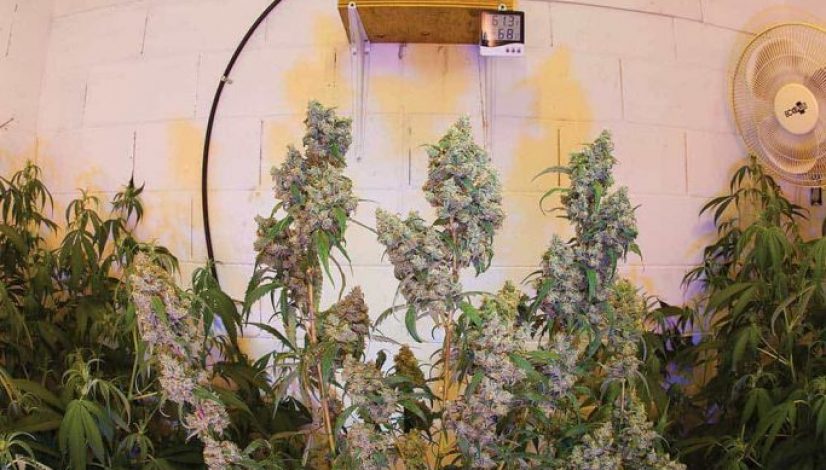The Urban Growroom
The post The Urban Growroom appeared first on High Times.
Stealth, noise reduction and odor control are always important for cannabis cultivators, but they become critical in crowded areas. Get street smart about growing weed in the city.
City Lights
Marijuana cultivation can prove difficult under the best of circumstances, but add in the unique challenges of growing in an urban environment and the stakes rise substantially. For apartment dwellers living in close proximity to nosy neighbors, growing pot at home requires a very particular set of skills. Issues such as odor control, noise suppression and flood-proofing are important for all pot farmers, but for those operating in cramped quarters, they become absolutely vital.
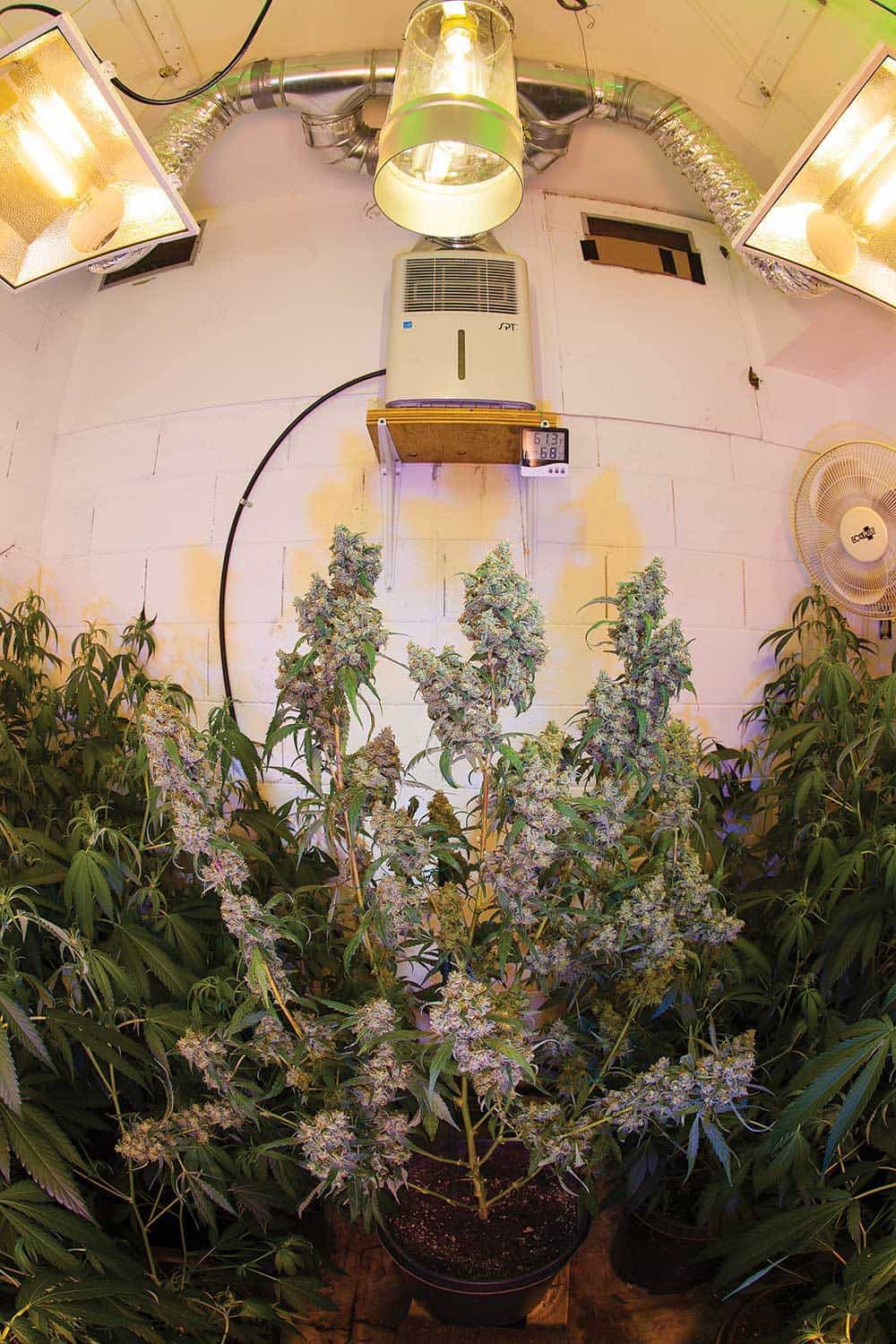
Lighting must be sized appropriately to available space.
The first decision you need to make is whether growing is right for you in your current situation. Keep in mind that the strong smell of freshly harvested cannabis can permeate an entire city block if uncontained. Safety and security require vigilance, so the place you choose to grow can’t be a party palace or crash pad.
Shady behavior becomes amplified in confined spaces, so you have to maintain the appearance of normality at all times. You certainly should never grow in a place where marijuana is being sold and people are coming in and out with any frequency. You may laugh at the notion, but I’ve encountered this behavior on multiple occasions in my travels. Your home must look like any other home in your vicinity or you risk attracting scrutiny, or far worse.
Closet, Bedroom, Tent Or Growbox?
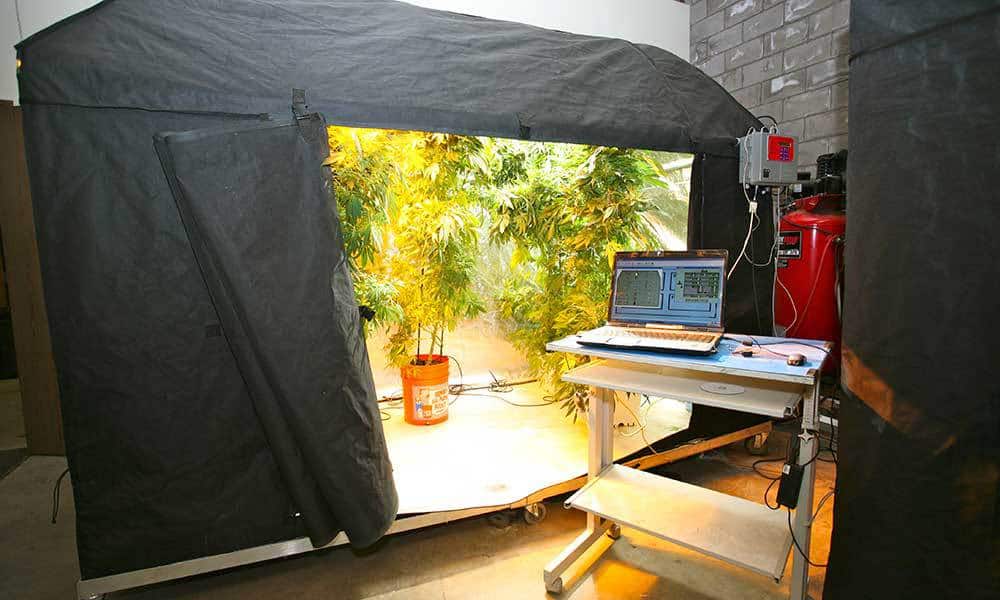
This grow tent features sophisticated monitoring equipment.
You have four basic options when it comes to growing in an apartment or small house: You can convert a closet or spare bedroom into your grow space, or you can purchase a growbox or tent. The first two options will require extensive work in order to ensure the proper amount of airflow, and they’re also tougher to move or take apart in case of an emergency. Growboxes provide a stealthy turnkey option, but their cost can be too high, and heat buildup can become an issue in some environments.
This leaves the grow tent as the best option in many cases. They’re affordable, easily assembled and disassembled, and many come in kits that include lighting, intake and exhaust fans with odor filters, growing mediums and even fertilizers. With many different sizes to choose from, grow tents provide a variety of solutions for small-scale cannabis cultivators.
Getting The Equipment In And Out
No matter how you choose to grow, you’ll need to find a way to get the necessary materials in and out of your space. Hauling grow-light systems, bags of soil mix and hydroponic reservoir tanks into a studio apartment in broad daylight is sure to arouse suspicion. So will trying to sneak these materials into your space in the middle of the night.
The answer is to disguise your equipment as normal household materials. A refrigerator box or other large appliance container can work wonders for concealing any large apparatus. A prominently placed aquarium in your home can help dispel questions about certain provisions and noises as well.
Stealth Bombing
The most essential element to urban growing is odor control. The telltale scent of marijuana can’t be allowed to permeate your limited space or drift outside of it. All spent air must be actively pumped through activated-charcoal filtration rated for the amount of space in which you grow.
Pumping air out will create negative pressure that pulls fresh air into your room from your intake fans and even from cracks beneath doors. If your growroom is entirely sealed, you’ll need to supplement it with carbon dioxide from a tank or generator with a meter and regulator.
Noise Suppression
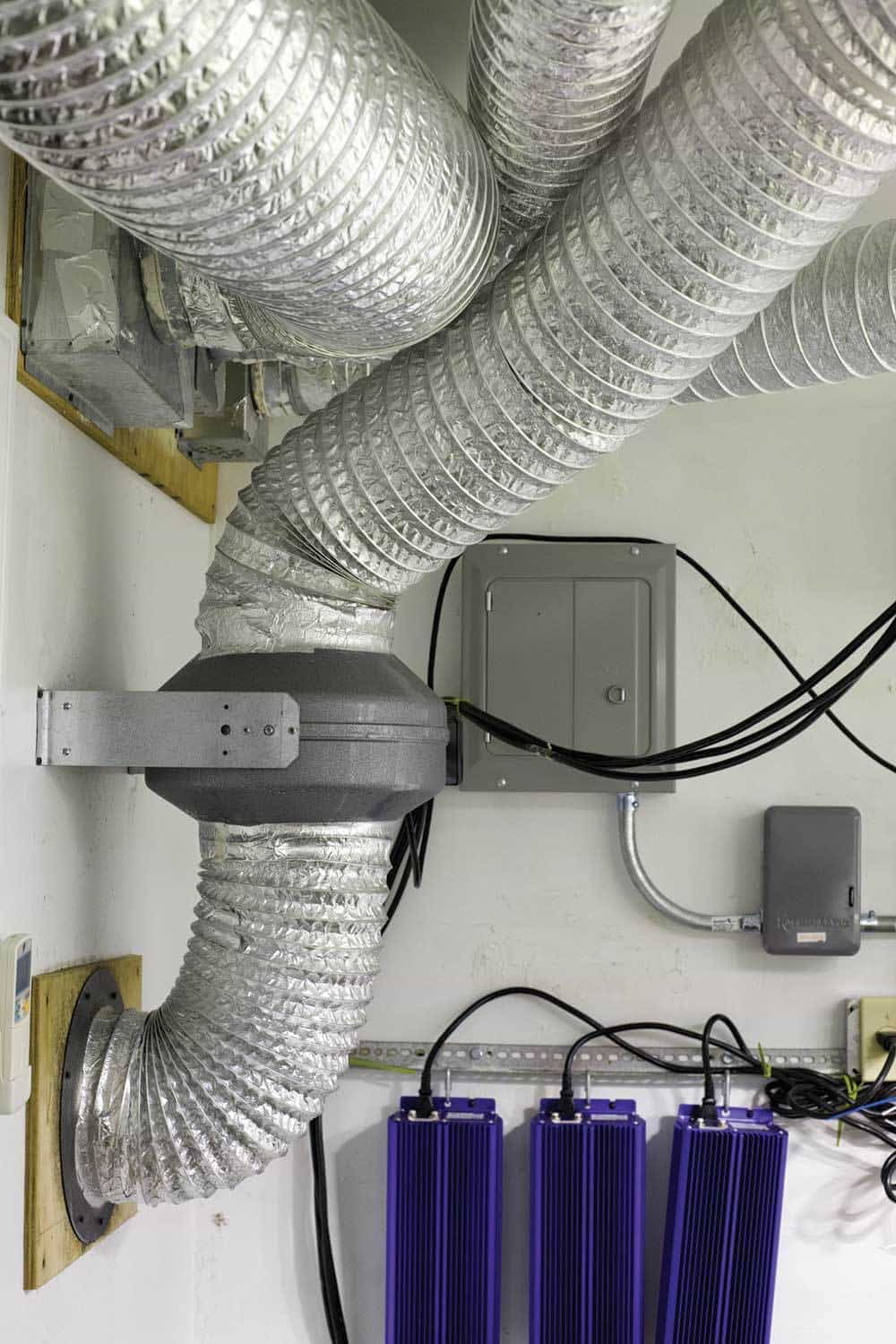
Avoid kinks in vent tubing. (Photo by Justin Cannabis/High Times)
There are several ways you can reduce the sound generated by grow equipment. Electronic ballasts that have a tendency to hum loudly should be mounted on rubber pads or hung from straps. Mufflers can be purchased or built and attached to exhaust fans and filters to stifle their noises. Install air and water pumps atop foam or rubber strips to reduce their sonic output. It’s nice to have the television on or music playing, but you should avoid having loud noises emanating from your home in the middle of the night.
Flood-Proofing
Aside from odor and noise, no other environmental factor can narc you out as quickly as a water leak. No matter where you decide to grow, you should create a space that can withstand a possible flood. Whether you hand-water your plants, use an automated-drip system or grow in deep-water buckets, there is always a chance of the nutrient solution getting on the floor or worse. Place a waterproof tarp underneath your grow and seal it up so that any potential deluge is contained.
This is even more important for hydroponic gardeners, because large amounts of liquid flow back and forth between the trays and reservoirs, and any leaks or breaks in the tubing can spell catastrophe, causing dozens of gallons to pour through your floor to the neighbors below.
Overcoming Odors
Apartment growers who want to realistically control the odors associated with growing cannabis should utilize air scrubbers similar to the ACSI Force Air 2000 or the Aeroclean 2000 “Econo” negative air-cleaning machine.
Large-scale growers with odor issues should investigate the use of an industrial-scale air-pollution scrubber, which can mitigate almost any air contamination, including cannabis odors. There’s a plethora of designs available; some simply filter and clean the air using nothing but water. If an oil refinery can clean its air to acceptable EPA standards utilizing this type of equipment, surely a cannabis-cultivation facility can do so as well. Google “air scrubber” and you’ll see that there are many options available to suit any requirement.
—K from Trichome Technologies, author of Marijuana Horticulture Fundamentals, Instagram @trichometechnologies
Environmental Control

Mother plants insure a steady supply of clones. (Photo by Justin Cannabis/High Times)
Virtually any space can be converted into a growroom, and with proper cloning skills, you can be quite productive. A huge key to a successful apartment grow is controlling your environment. Temperature and humidity must be monitored and regulated. All outgoing air must be cleaned with carbon scrubbers. MzJill and I started TGA Genetics in an 8′ x 10′ extra room that went undetected for four years.
—Subcool, breeder of TGA Genetics, Instagram @theweednerd420
Air Conditioning
Exhaust growroom air into carbon filters in a separate room and keep the window open (if possible) to allow the air to ease out quietly. Keep your fans and ballasts from vibrating and humming. Use tarps on the floor in case of leaks. Also, split-system air conditioning is ideal for urban grows.
—JJNYC, breeder of Top Dawg Seeds, Instagram @topdawgseeds
Dealing With Limited Space
Vertical systems, especially hydroponics, allow for higher yields with less cropping time in the same-sized linear footprint. Don’t think flat—grow in all three dimensions for more production in limited spaces. Higher plant densities also mean less veg time for more crops of bud per year.
Equipment like fans and dehumidifiers can rattle ceilings, walls and floors—possibly annoying others or those in your own household. Using rubber straps or bungee cords in eyehooks to suspend equipment will greatly dampen noise and vibrations. Also, sealed growrooms don’t tell everyone you’re cultivating cannabis because they don’t require noisy or obvious exhaust and intake fan ducts to the outdoors. While this is a more spendy option, the AC, CO2 gear and humidity controls will eliminate the need for such obtrusive openings, while giving you better and more consistent cannabis crops.
Finally, you should look to conserve valuable power consumption and space. You’ll simply be wasting limited resources if you use an entire room and high-intensity discharge (HID) lighting to veg young cannabis plants that don’t require all that space or light intensity in their growing environment. Stage your crop throughout the room to maximize efficiency for lower power bills and healthier plants with fewer chances of problems.
—Submitted via Happy Seeds Company, happyseedscompany.com, Instagram @happyseedscompany
Prevent Flooding And Light Leaks
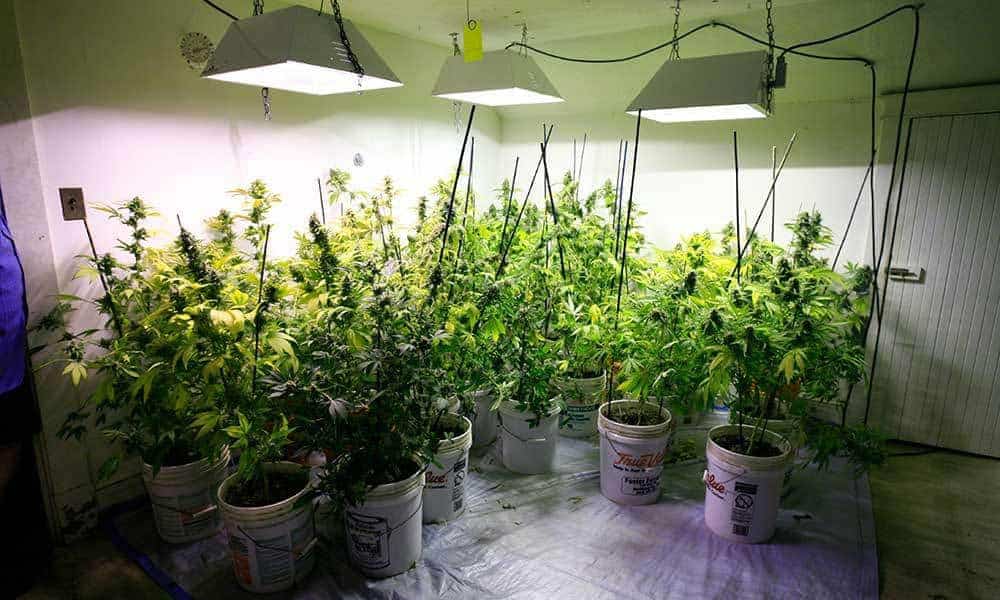
Tarps can contain flooding to avoid detection. (Photo by Brian Jahn/High Times)
You want to make sure to trough or bed-line the area with tarps as a safeguard for catching leaks and avoiding water damage. This is especially important if you’re growing on an upper level. Also, by placing a combination fan/carbon filter as an exhaust at the ceiling of your grow tent and opening the smaller bottom ports, you’ll create a negative pressure that will filter odors and circulate the air.
Other factors to consider: Use rubber pads or mats under anything that vibrates; it helps to muffle the noise. Consider LED lighting for its low heat output and energy use. And always keep an eye out for light leaks; otherwise, people might think that Jesus is your roommate.
—Eric, MassCannabis Consulting Inc., Instagram @masscannabis
The Right Stuff
The air in your growroom should exchange every five to eight minutes. With this in mind, the first step in building a silent growroom is buying a fan that draws the exact amount of air you’ll need, instead of trying to reduce the speed of a fan that’s too powerful. The more air a fan draws in, the louder it will be and the more work you’ll have to do to silence it—but reducing the fan speed with controllers forces the fan to run at suboptimal conditions and will lower its life and performance.
Also, exhaust air exiting a duct at high speed makes a very audible whooshing sound that has given away countless grow ops. You can either purchase or build a muffler for very little money. The muffler decreases the speed of the air and reduces turbulence, and even a DIY setup made with a trash bin, glass wool and chicken wire can make your airflow almost completely inaudible.
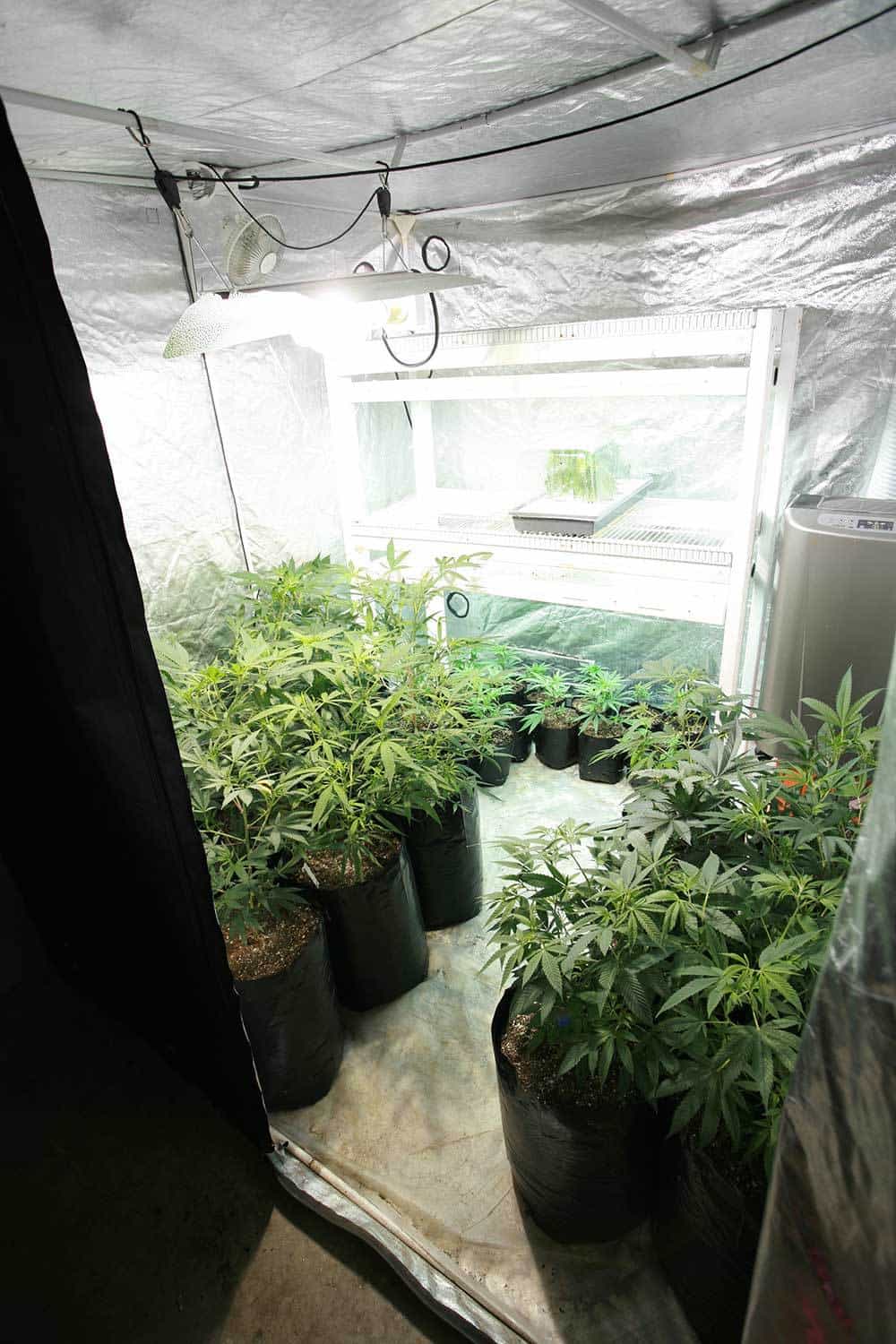
Light must not leak out from your closed space. (Photo by Brian Jahn/High Times)
Both flexible and rigid metallic ducting can carry vibrations and cause noisy turbulence that will compromise your stealth. Not only is fabric ducting easier to install than either of these more common options, but it lends itself excellently to ventilation situations that require silence. Many stealthy growers also recommend insulated ducting for the last stretch of the duct before the air exits to the outside.
While it may cost a pretty penny, the fiberglass insulation designed to contain heat also absorbs sound excellently. If you do use ducting that isn’t made of fabric, be sure to minimize the bends and turns that it makes, which create noisy turbulence.
In order to prevent vibrations that the fan creates from going through the floor, walls or ceilings, it shouldn’t directly come into contact with any of these surfaces. Enclosing the fan in a wooden box and suspending it from the ceiling with bungee cords will prevent any vibrations from traveling beyond the enclosure. Seal up any cracks with acoustically rated caulk and you’ll be good to go. If you have metal air ducts, suspending them from bungee cords will drastically reduce sound transmission through the ceiling.
Air and water pumps typically rest on the ground and produce noise and vibrations that are capable of penetrating both floors and walls. Placing a high-density foam or rubber surface between them and the floor will attenuate the vibrations, making them as quiet as possible. If you’ve already invested in acoustical duct wrap or some other soundproofing material, cut out a few squares and place the pumps on them. Just make sure that whatever you use, it’s made of a flame-retardant material.
Putting noisy air pumps on foam padding will block vibrations from going through the floor, but they’ll still emit sound into the surrounding air—and a lot of it. It may seem counterintuitive, but air pumps make more noise the less resistance they work against. Placing more airstones in a series will make your pump work much more quietly, in addition to providing more distributed oxygenation to your reservoir; it just takes some simple plumbing.
If the above solutions aren’t enough because you absolutely need silence, then the entire room requires soundproofing. Certain architectural techniques and materials can be incorporated into the construction of a house or the walls of a room, but tearing up walls and flooring isn’t an option for people that pay rent. Installing rubber underlayments, which go beneath the linoleum or wood floor surface, doesn’t entail as much work or expertise as ripping up walls, and they may be the first option for someone who wants to make a permanent alteration to the room.
If you can’t make permanent alterations, you can hang up vinyl curtains (such as those used in garages and loading bays) for relatively cheap. Pyramid-panel acoustic foam hung on the walls will cut down on high-pitch frequencies, but blocking low and medium tones requires heavy materials like rubber. Don’t waste your time with egg cartons—they’re highly flammable and don’t block as much sound as you think. Seal up all cracks with acoustically rated caulk and make sure that everything is completely fire-safe and that all of the materials are nonflammable!
—Sirius J., High Times cultivation reporter, facebook.com/John.SmytheIII
Stealth And Safety Are Key
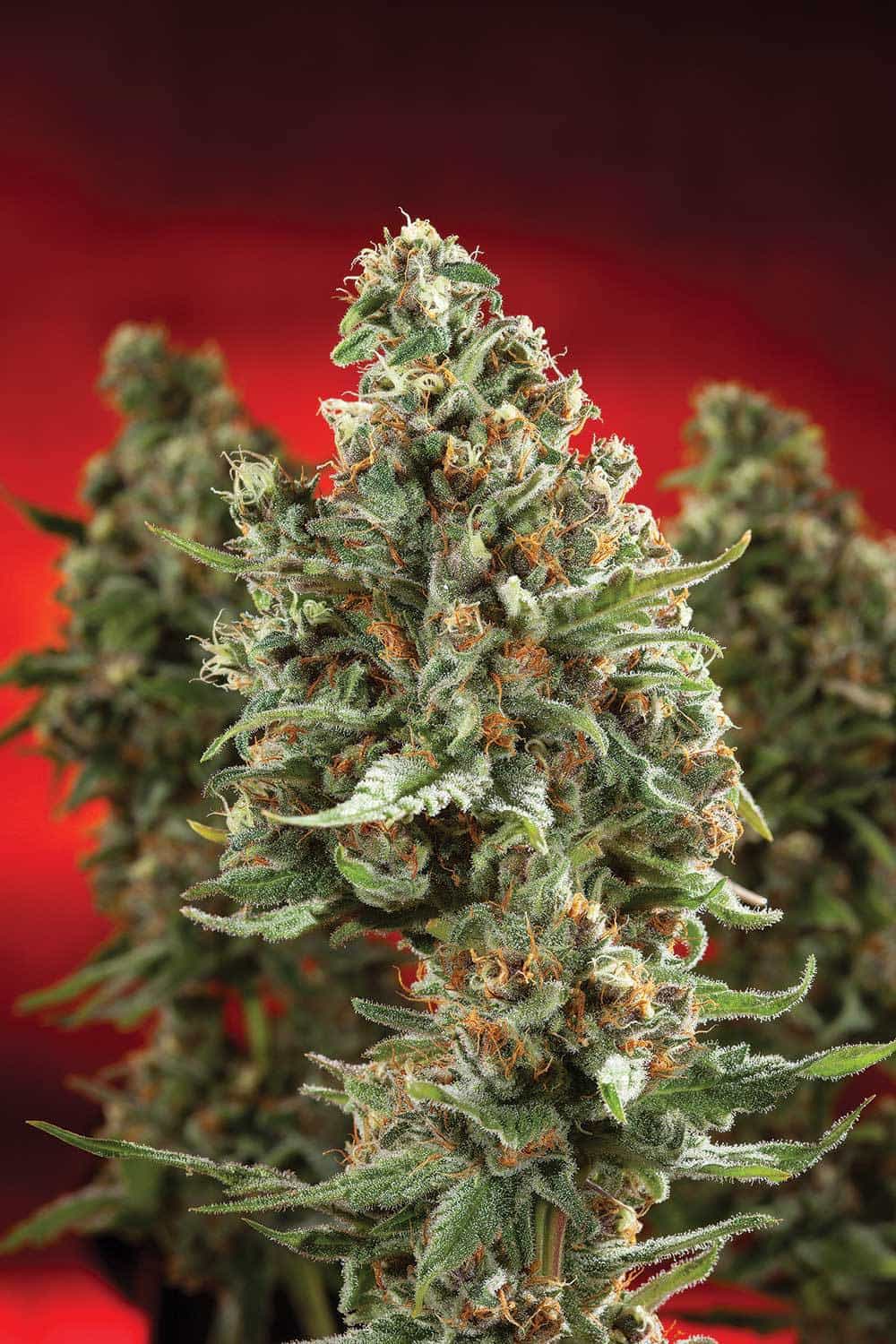
Joyride (Photo by Justin Cannabis/High Times)
You must ensure that your growing setup is safe and clean. All wiring must be done properly, with safeguards in place and never exceeding your electrical capacity. Check out how we wire our boxes at 14 to 18 seconds into this video at bcnorthernlights.com/company-culture.
Stealth is the other paramount concern. Because you have others close to your crop and with possible access to your apartment, it’s important to ensure proper ventilation (without having to cut holes in your walls); odor reduction via negative air pressure that pulls exhausted air through odor-scrubbing activated-carbon filters; plus lockable doors and wheels so you can roll it all out to a friend’s house at a moment’s notice. (PS: BC Northern Lights growboxes address all of these concerns!) Also, CO2 injection can be a great way to maximize your yields in small spaces and will also serve as a natural pest deterrent. (PSS: You’re not going to believe this, but BC Northern Lights offers an automated CO2-injection system with its growing appliances!)
Last but not least, don’t be greedy; share your bounty with your neighbors. You’ll be far more appreciated than bringing an ambrosia salad to your next block party.
—Tarren from BC Northern Lights, Twitter @BCNL420
The post The Urban Growroom appeared first on High Times.

